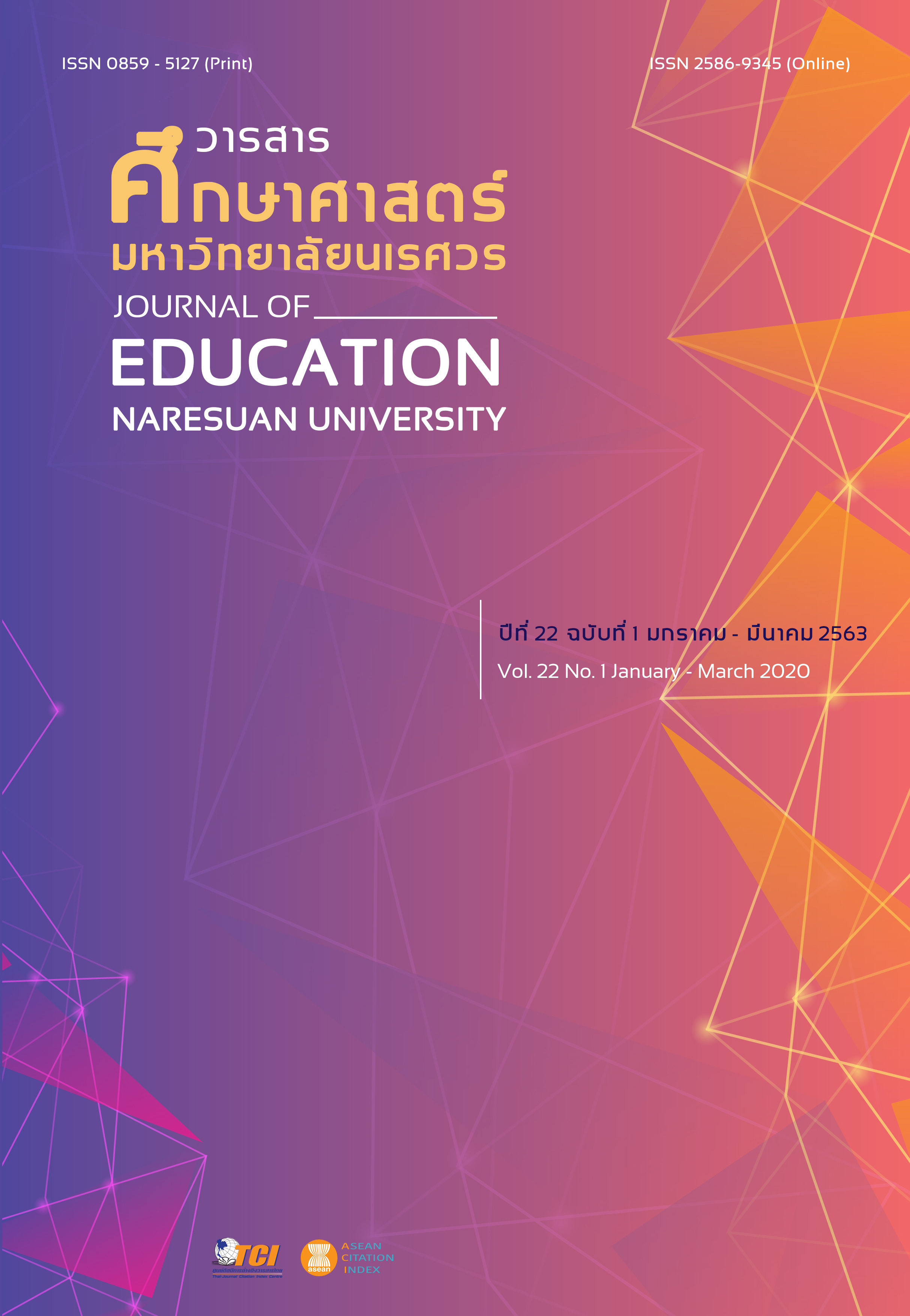A STUDY OF SCIENTIFIC ANALYTICAL THINKING AND LEARNING ACHIEVEMENT OF TENTH GRADE STUDENTS THROUGH CONTEXT-BASED LEARNING EMPHASIZING ANALYTICAL THINKING ON SOLID LIQUID GAS
Main Article Content
Abstract
The objectives of this research were to compare the posttest scores of students’ scientific analytical thinking and learning achievement through context-based learning emphasizing analytical thinking (CBL-EAT) on solids, liquids, and gases with pretest scores and to compare the posttest scores of students’ learning achievement through CBL-EAT on solids, liquids, and gases with the 70 percent criteria. The participants were 45 tenth grade students who were selected randomly using the cluster random sampling technique. The research instrument consisted of 1) CBL-EAT on solids, liquids, and gases lesson plans, 2) scientific analytical thinking test, and 3) learning achievement test. The data was analyzed by the percentage, mean, standard deviation, one sample t-test, and dependent samples t-test. The results of this study indicated that: The posttest scores of students’ scientific analytical thinking and learning achievement through CBL-EAT on solids, liquids, and gases were statistically significant higher than the pretest scores of those at the .01 level and the posttest scores of students’ learning achievement through CBL-EAT on solids, liquids, and gases were statistically significant higher than the 70 percent criteria at the .01 level.
Article Details
The owner of the article does not copy or violate any of its copyright. If any copyright infringement occurs or prosecution, in any case, the Editorial Board is not involved in all the rights to the owner of the article to be performed.
References
Academic Department, Assumption College Sriracha. (2017). Report of the Ordinary National Educational Test (O-NET) of twelfth grade students in academic year 2016. Chonburi: Academic Department, Assumption College Sriracha.
Barak, M., & Hussein-Farraj, R. (2013). Integrating model based learning and animations for enhancing students’ understanding of proteins structure and function. Res. Sci. Educ., 43(2), 619–636.
Barker, V. (1999). Students’ reasoning about chemical reactions: What changes occur during a context-based post-16 chemistry course. International Journal of Science Education, 21(6), 645-665.
Bennett, J. (2003). Teaching and learning science : A guide to recent research and its applications. London: Continuum.
Bennett, J. & Holman, J. (2002). Context-Based Approaches to the Teaching of Chemistry: What are They and What Are Their Effects? In J. Gilbert (Ed.), Chemical education: Towards research-based practice (pp. 165-184). Dordrecht: Kluwer Academic Publishers.
Brookhart, S. M. (2010). How to assess higher-order thinking skills in your classroom. Alexandria: ASCD.
Brown, T. L., & LeMay, H. E. (1977). Chemistry: The central science. Englewood Cliffs, New Jersey.: Prentice Hall.
Cohen, L., Manion, L., & Morrison, K. (2007). Research methods in education. New York: Routledge.
Educational Broadcasting Corporation. (2004). Constructivism as a paradigm for teaching and learning. Retrieved from https://www.thirteen.org/edonline/concept2class/constructivism/index.html
Gilbert, J. K. (2006). On the nature of “Context” in chemical education. International Journal of Science Education, 28(9), 957 -976.
Harris, R., Hobart, B., & Lundberg, D. (1995). Competency-based education and training: Between a rock and a whirlpool. South Yarra: Macmillan Publ. Australia.
Kijkuakul, S. (2012). Nature of science and its learning benchmarks. Journal of Education Naresuan University, 14(3), 199-124.
Macklin, A. S., & Fosmire, M. (2003). Real-world solutions for real-world collaboration problems. Libraries Research Publications. Retrieved from https://docs.lib.purdue.edu/lib_research/41
Marzano, R. J., & Kendall, J. S. (2007). The new taxonomy of educational objectives (2nd ed.). California: Corwin Press.
McMillan, J. H., & Schumacher, S. (2001). Research in education: A conceptual introduction (5th ed.). New York: Longman.
Office for National Education Standards and Quality Assessment (ONESQA). (2012). Third level external quality assessment guide (2011-2015) basic education level school edition (Revised November 2011). Bangkok: Offset Plus.
Özay, K. E., & Çam, T. F. (2015). Effects of context based learning on students’ achievement and attitudes in biology. K. Ü. Kastamonu Eğitim Dergisi, 23(4), 1425-1436.
Panprueksa, K., Phonphok, N., Boonprakob, M., & Dahsah, C. (2013). The development of FEACA model to enhance students’ conceptual understanding, analytical thinking, and application of knowledge. Sripatum Review of Humanities and Social Sciences, 13(2), 7-16.
Pramchoo, J., Sreethunyoo, A., & Meesuk, L. (2010). The effect of using context-based learning activities on grade-11 student achievement in chemistry. Journal of Srinakharinwirot Research and Development, 2(supplement 1), 32-41.
Sudibyo, E., Jatmiko, B., & Widodo, W. (2016). The effectiveness of CBL model to improve analytical thinking skills the students of sport science. International Education Studies, 9(4), 195-203.
Taconis, R., Brok, P. D., & Pilot, A. (2016). Teachers creating context-based learning environments in science. Rotterdam: Sense.
The Organisation for Economic Co-operation and Development (OECD). (2016). PISA 2015 results (Volume I): Excellence and equity in education. Paris: OECD Publishing.


